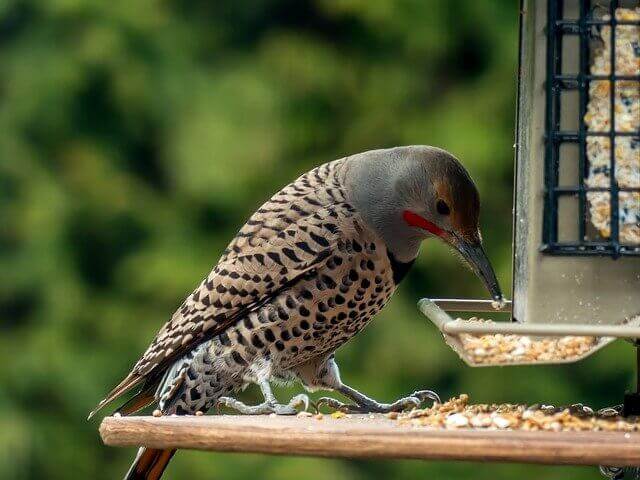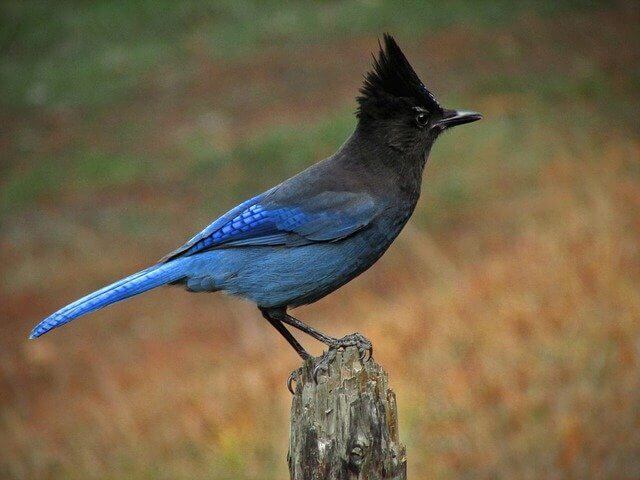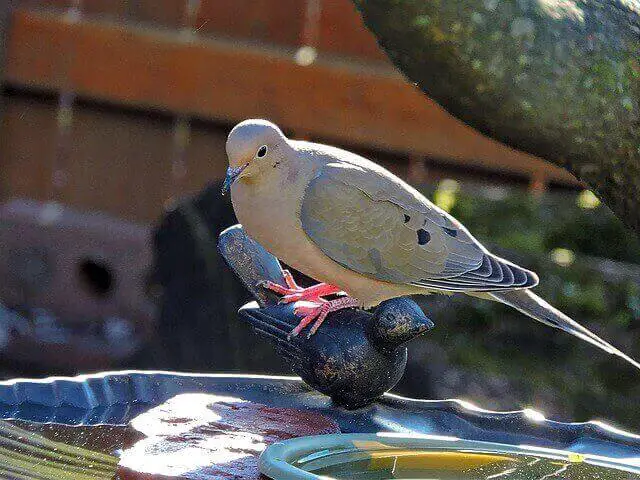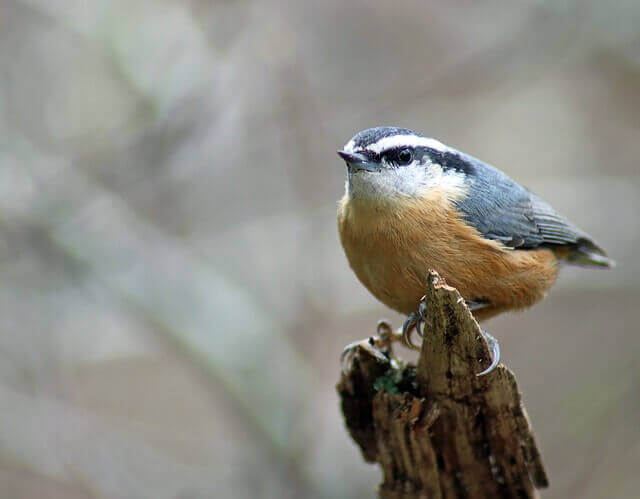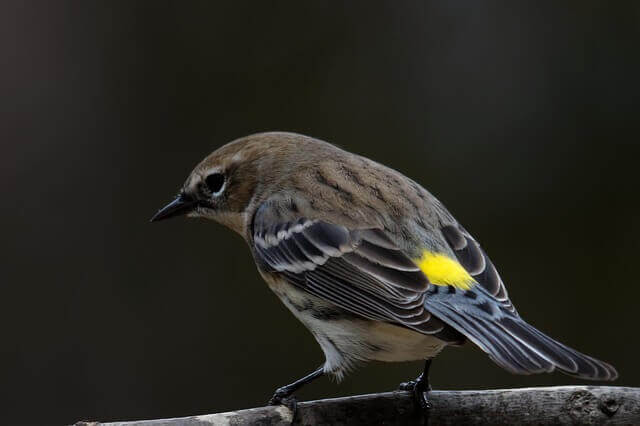Welcome to Oregon’s vibrant avian landscape! From the coastal shores to the rugged mountains, Oregon is home to a diverse array of bird species. In this ultimate guide, we’ll introduce you to the 56 most common birds you’re likely to encounter across the Beaver State. Whether you’re a seasoned birder or a curious beginner, this comprehensive guide will enrich your birdwatching adventures in Oregon.
Table of Contents
- 1 Most Common Birds In Oregon
- 1.1 American Robin
- 1.2 Song Sparrow
- 1.3 American Crow
- 1.4 Dark-eyed Junco
- 1.5 Northern Flicker
- 1.6 Black-capped Chickadee
- 1.7 Spotted Towhee
- 1.8 European Starling
- 1.9 California Scrub-Jay
- 1.10 Steller’s Jay
- 1.11 House Finch
- 1.12 Red-winged Blackbird
- 1.13 Anna’s Hummingbird
- 1.14 Mourning Dove
- 1.15 Red-breasted Nuthatch
- 1.16 American Goldfinch
- 1.17 Common Raven
- 1.18 White-crowned Sparrow
- 1.19 Yellow-rumped Warbler
- 1.20 Golden-crowned Sparrow
- 2 Frequently Asked Questions
- 2.1 What bird is Oregon known for?
- 2.2 What is the largest bird in Oregon?
- 2.3 What Oregon birds nest on the ground?
- 2.4 What kind of chickadees live in Oregon?
- 2.5 Are there grackles in Oregon?
- 2.6 Are there orioles in Oregon?
- 2.7 Are there peacocks in Oregon?
- 2.8 Are golden eagles in Oregon?
- 2.9 Do we have cardinals in Oregon?
- 2.10 Are there starlings in Oregon?
- 2.11 What kind of black birds are in Oregon?
- 2.12 Are there vultures in Oregon?
- 2.13 Do we have falcons in Oregon?
- 3 Author
Most Common Birds In Oregon
American Robin
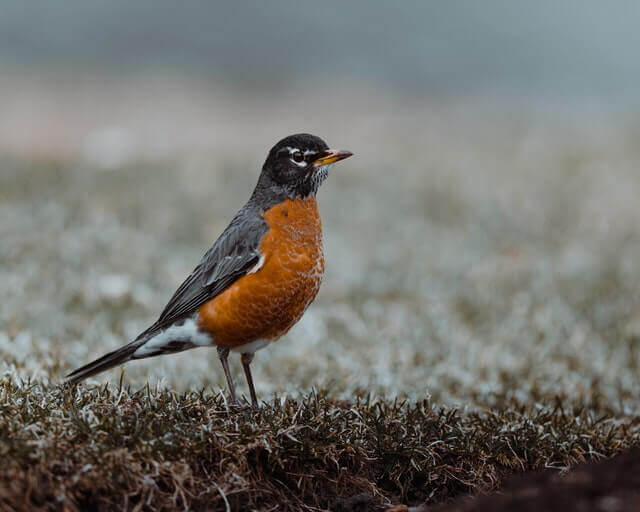
The American Robin is common throughout most of North America. These birds are easily recognizable by their bright red breasts, and they are often heard singing in the early mornings. Robins are found in a wide range of habitats, from woodlands to suburban gardens. They will also nest in a variety of places, including on porch rails and in trees.
Robins are primarily insectivorous but also enjoy consuming berries and fruits. In the springtime, you may see them eating earthworms that have come to the surface after a rain shower. In the fall, robins will fatten up on berries in preparation for migration. Some of the berries that robins eat include: cherries, juniper berries, dogwood berries, and poison ivy berries.
- Frequency: 39.86% (Statistic: eBird)
- Color: Mostly brown on the back with an orange colored breast
- Habitat: Wooded areas, backyards, parks, fields
- Range: USA, Canada, Mexico
- Size: 12 – 16″ inches
- Weight: 72 – 95 grams
- Diet: Fruits, berries and insects (earthworms, beetles, caterpillars)
- Family: Turdidae
- Genus: Turdus
- Maps: Range Map – Sightings Map
- Sounds: Call and Songs
Related:
- How To Attract Robins To Your Yard – 7 Best Tips!
- 5 Best Bird Feeders For Robins (Tested & Rated For 2022)
- Interesting American Robin Fun Facts
Song Sparrow
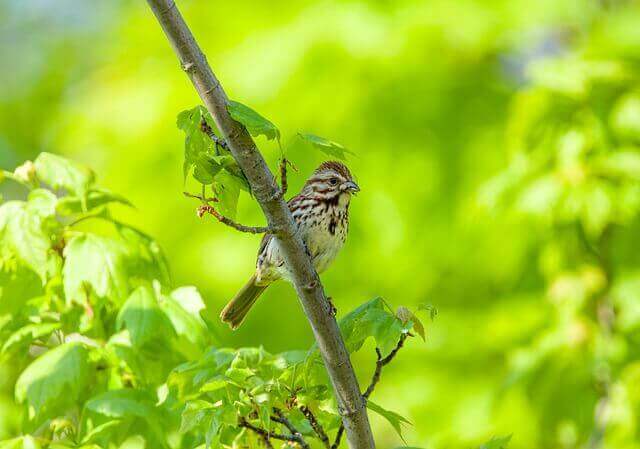
The Song Sparrow (Melospiza melodia) is a small American sparrow. Common throughout North America, it is one of the most widespread of all North American birds. It is also one of the most variable, with over 30 recognized subspecies. A medium-sized sparrow, it has a brown back with black streaks, a gray breast with buff streaks, and a streaked throat. The sexes are similar in plumage, but females and juveniles are generally duller than males.
The song sparrow is found in nearly all habitats, from open fields to forests edge to city parks. It is a very adaptable bird and can even nest in urban areas. The song sparrows’ diet consists primarily of insects and seeds. In winter, when insects are scarce, the bird will switch to a diet of mainly seeds.
- Frequency: 38.84%
- Color: Gray head, white cheek, a black bib, rufous neck
- Habitat: Urban centers, farms, backyards, edges, yards, and parks
- Range: Europe, Mediterranean, Asia, Australasia, Africa, and the Americas
- Size: 5.5 – 7.0″ inches
- Weight: 25 – 40 grams
- Diet: Grains, seeds, and insects
- Family: Passeridae
- Genus: Passer
- Maps: Range Map – Sightings Map
- Sounds: Call and Songs
Related: How to Attract Sparrows to your Backyard
American Crow
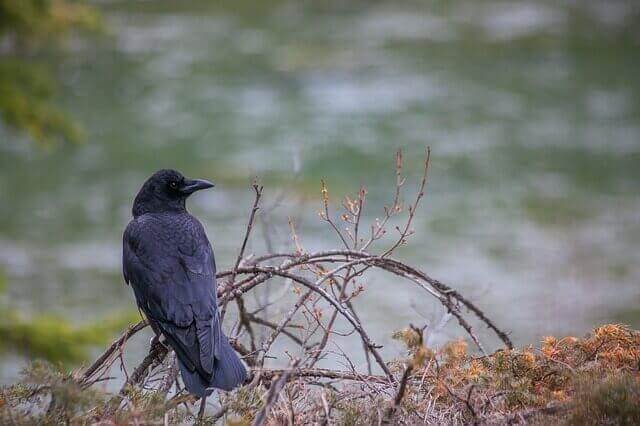
The American Crow is a species of bird that can be found in North America. They are common throughout the continent, and their range extends from Alaska to Newfoundland.Their habitat is typically in wooded areas, but they can also be found in open fields or near bodies of water. Crows are omnivorous birds, and their diet consists of both plant and animal matter.
They will eat insects, small mammals, eggs, fruits, and grain. American crows will also scavenge for food, and they are often seen around garbage dumps or roadkill. While they are not considered to be endangered, the population of American crows has declined in recent years due to factors such as habitat loss and pesticide use. However, they are still a common sight in many parts of the United States.
- Frequency: 33.06%
- Color: Black
- Habitat: Open country, farms, parks, woodlands, towns, cities
- Range: Canada, USA, Mexico
- Size: 16 – 21″ inches
- Weight: 315 -620 grams
- Diet: Invertebrates, carrion, seeds, eggs fish, grains, mice, frogs, and other small animals.
- Family: Corvidae
- Genus: Corvis
- Maps: Range Map – Sightings Map
- Sounds: Call and Songs
Related: How To Attract Crows To Your Backyard: Expert Tips!
Dark-eyed Junco
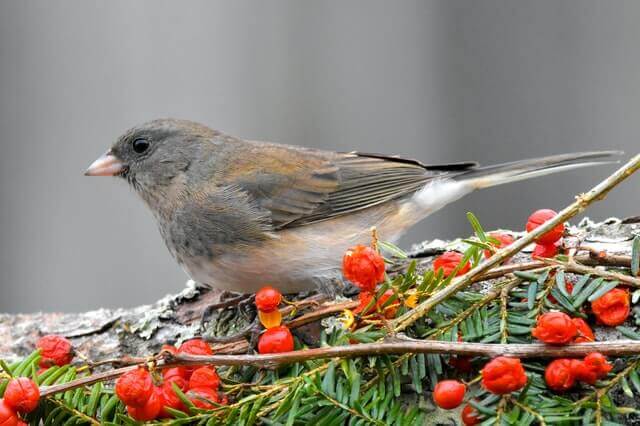
The Dark-eyed Junco is a small sparrow with gray upperparts and white underparts. Its outer feathers are gray with white inner tips. The bill is pinkish. Males have a dark gray hood, while females have a brown hood. The dark-eyed junco breeds in North America from Alaska to Labrador, and south to California, Arizona, New Mexico, Colorado, Nebraska, the Dakotas, Minnesota, Wisconsin, Michigan, New York, Vermont, New Hampshire, and Maine.
It winters in southern Canada and the northern United States, from British Columbia to Nova Scotia south to Virginia and Missouri. The dark-eyed junco forages on the ground for seeds and insects. It also eats berries and fruits.
- Frequency: 32.73%
- Color: Gray head, neck, breast, gray/brown backs and wings, white underside
- Habitat: Wooded areas, forest edges, roadsides, gardens, parks.
- Range: USA and Canada
- Size: 5.1 – 6.9″ inches
- Weight: 18 – 30 grams
- Diet: Seeds, insects, and arthropods
- Family: Passeriformes
- Genus: Junco
Related: Fun Facts About Dark-eyed Juncos
Northern Flicker
One of various woodpeckers, the Northern Flicker is part of the woodpecker family. These birds are found in North America, with the majority of the population in Canada. The Northern flicker is named for its habit of feeding on ants and other insects. These birds are also known to eat fruits, berries, and seeds. The Northern flicker has a wingspan of about 17-20″ inches and a length of about 10-14″ inches.
The male Northern flicker has a red patch on the back of its head, while the female does not. The Northern flicker is a shy bird that is not often seen by humans. However, these birds can be heard drumming on trees or fences when they are looking for mates.
- Frequency: 30.55%
- Color: Light brown with black bars across back, chest, wings, belly
- Habitat: Forests, woodlands, backyards, edges, yards, and parks
- Range: North America, Central America, Cuba, Cayman Islands
- Size: 10 – 14″ inches
- Weight: 85 – 165 grams
- Diet: Insects (ants, beetles, invertebrates), fruits, seeds, berries
- Family: Picadae
- Genus: Colaptes
Related: How to Attract Northern Flickers to your Backyard? (Easy)
Black-capped Chickadee
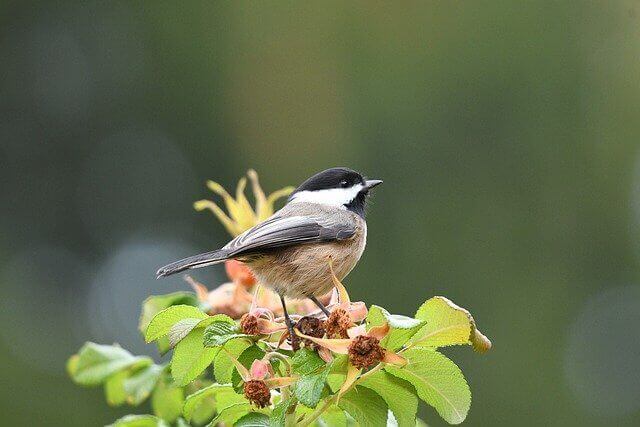
The Black-capped Chickadee is a small, sprightly bird found in woods and forests across North America. These cute little birds are well-known for their bold black and white plumage, as well as their distinctive call of “chick-a-dee-dee-dee”. Chickadees are very adaptable birds, and can be found in a variety of habitats including deciduous and coniferous forests, urban parks, and even your backyard!
These friendly little birds are not shy about coming close to humans, and will often take food from your hand. Chickadees are mostly insectivorous, but will also eat seeds, berries, and nuts. In wintertime, when insects are scarce, they will often form flocks with other small birds and forage together for food.
- Frequency: 29.24%
- Color: Black-cap, white on face, white/reddish-brown flanks
- Habitat: Deciduous and mixed forests, backyards, parks
- Range: USA and Canada
- Size: 11.5 -16 cm length
- Weight: 8 – 15 grams
- Diet: Insects, seeds, berries
- Family: Paridae
- Genus: Poecile
Related: How Do I Attract Chickadees To My Yard?
Spotted Towhee

The Spotted Towhee is a medium-sized bird that is found in woodlands throughout western North America. The Spotted Towhee has a black head, back, and wings with white spots, and a rusty-red breast. The Spotted Towhee is about 6.5-8.5 inches in length, with a wingspan of 11 inches. The Spotted Towhee is found in forests, woodlands, and brushy areas from southern Alaska to northern Mexico.
The Spotted Towhee prefers habitats with dense vegetation such as mountain forests, foothill woodlands, and riparian woodlands. The diet of the Spotted Towhee consists mainly of insects and other small invertebrates. The Spotted Towhee will also eat berries and seeds.
- Frequency: 28.48%
- Color: A black head, upper body and tail with a white belly, reddish-brown sides, white wing bars, and white spots on back.
- Habitat: Wetland forests, riparian forests, upland forests, scrubland, suburban garden, and parks.
- Range: Washington, Utah, Arizona, Nevada, Oregon, and Southern British Columbia.
- Size: 6.7″ – 8.3″ inches
- Weight: 33 – 49 grams
- Diet: Insects, beetles, spiders, arthropods, acorns, seeds oats and berries.
- Family: Passerellidae
- Genus: Pipilo
Related: How to Attract Towhee to your Backyard? Expert Tips!
European Starling
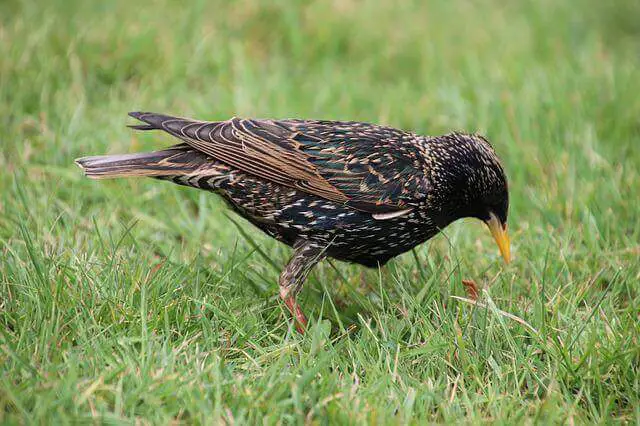
The European Starling is a species of starling that is native to Europe and Asia. The bird is often called the Common Starling, or simply the Starling. The bird is about 20 cm in length with a wingspan of about 30 cm. The plumage is black with white spots in the summer, and brown with white spots in the winter. The bill is yellow, and the legs are pink. The European Starling has a large range, extending from Iceland and Scandinavia to Russia, Turkey, and Morocco.
In North America, the bird ranges from Alaska to Newfoundland, and south to California and North Carolina. The bird prefers open habitats such as farmland, meadows, and pastureland. However, the bird can also be found in urban areas such as parks and gardens. The diet of the European Starling consists primarily of insects.
- Frequency: 27.26%
- Color: Black with glossy iridescence plumage.
- Habitat: Forests, woodlands, backyards, edges, yards, and parks.
- Range: North America, Europe, Africa, India, Middle East, China.
- Size: 7 – 9″ inches long
- Weight: 60 – 100 grams
- Diet: Insects (ants, beetles, invertebrates), fruits, seeds, berries
- Family: Sturnidae
- Genus: Sturnus
Related: How To Attract European Starlings To Your Yard Fast?
California Scrub-Jay
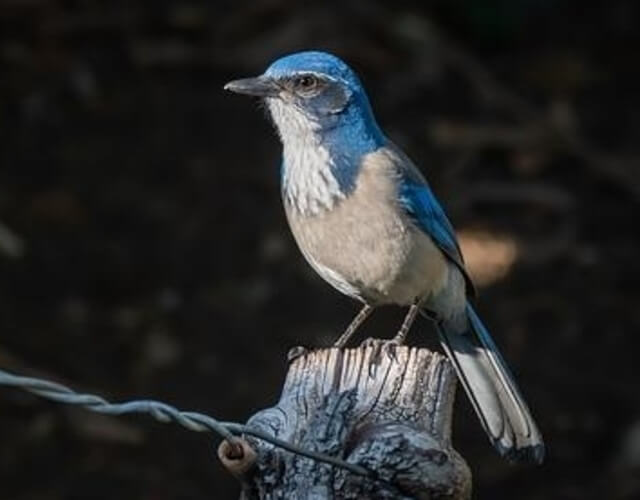
The California Scrub-Jay is a bird that is found in the western United States. The range of the California Scrub-Jay extends from southern Oregon to central California. The habitat of the California Scrub-Jay consists of open areas with scrub vegetation. The diet of the California Scrub-Jay consists of insects, berries, and nuts.
The California Scrub-Jay is a relatively small bird. The adult California Scrub-Jay weighs between 70 and 80 grams. The body length of the adult California Scrub-Jay ranges from 28 to 30 cm. The wingspan of the adult California Scrub-Jay ranges from 37 to 39 cm. The plumage of the male and female California Scrub-Jays is similar. The upperparts of the California Scrub-Jays are blue with a white breast and belly.
- Frequency: 27.21%
- Color: Blue head, tail, and wings, a grayish-brown back, gray underparts, and white eyebrows. White throat with a blue necklace
- Habitat: Deciduous and mixed evergreen forests, low-scrub, mixed woodlands, backyards, parks.
- Range: Western North America, Southern British Columbia, California, Western Nevada, Sierra Nevada.
- Size: 11– 12″ inches
- Weight: 80 grams
- Diet: Frogs, lizards, insects, grains, nuts, berries, fruit and vegetables
- Family: Corvidae
- Genus: Aphelocoma
Steller’s Jay
The Steller’s Jay belongs into the crow and jay family. It is native to western North America, ranging from southern Alaska to northern Mexico. The Steller’s Jay has a black head with blue throughout the rest of its body.
The Steller’s Jay inhabits coniferous forests. It is also found in woodlands, scrublands, and urban areas. The bird prefers trees with dense foliage for nesting. The diet of the Steller’s Jay consists of insects, berries, nuts, and seeds. The bird will also eat eggs and nestlings of other birds.
- Frequency: 21.76%
- Color: Charcoal black head and the body is all blue. White markings above the eye.
- Habitat: Coniferous forests, residential and agricultural areas with nearby forests.
- Range: Pacific Ocean coast of North and Central America, Alaska all the way to Nicaragua.
- Size: 12 – 13″ inches
- Weight: 100 -140 grams
- Diet: Snakes, lizards,invertebrates, small rodents, eggs, seeds, nuts, berries and other fruit.
- Family: Corvidae
- Genus: Cyanocitta
Related: How to Attract Steller’s Jay to your Yard – Expert Tips!
House Finch
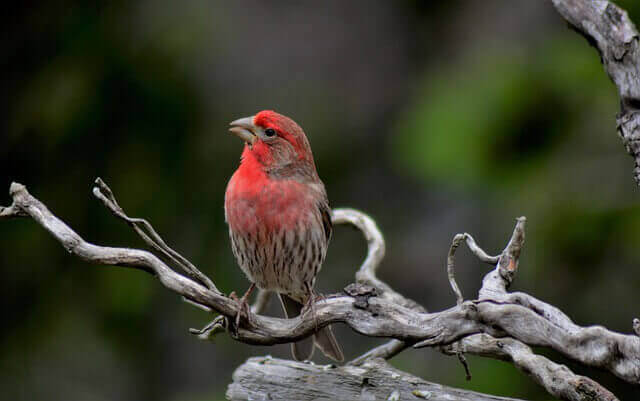
The House Finch is a small bird that is native to North America. It has a rosy red face and upper breast and a streaked brown belly, back and tail. The male House Finch has a red head and breast, while the female has a grayish brown head and breast. The House Finch typically measures between 5 and 6 inches in length and weighs between 15 and 30 grams.
The House Finch ranges from southern Canada to northern Mexico. It can be found in woodlands, grasslands, deserts, and urban areas. The bird prefers to nest in trees, but will also nest in shrubs and on buildings. The House Finch diet consists mainly of seeds, fruits, and insects.
- Frequency: 20.67%
- Color: Reddish face and upper breast, brown streaks on back, belly, and tail.
- Habitat: Urban and suburban areas, backyards, edges, yards, and parks.
- Range: Canada, USA, Mexico
- Size: 5 – 6″ inches
- Weight: 16 – 27 grams
- Diet: Aphids, grains, seeds, berries, nettle, dandelion, sunflower
- Family: Fringillidae
- Genus: Haemorhous
Related: How to Attract House Finch to Your Yard?
Red-winged Blackbird
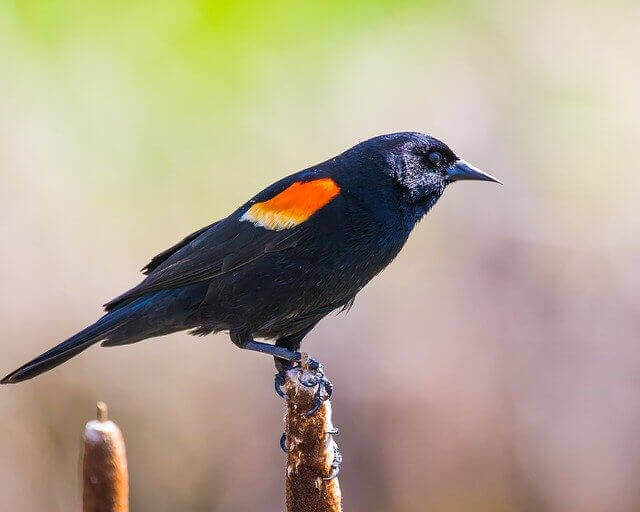
The red-winged blackbird (Agelaius phoeniceus) is a member of the family Icteridae. The male has distinctive red shoulder patches and a yellow bar on its wing. The breeding habitat of the red-winged blackbird is marshes and wet meadows across most of temperate North America. The nest is built in a tree or shrub, often near water.
This blackbird is a polygynous breeder; the male builds several nests and mates with several females. The female incubates the new offspring and raises them alone. The diet of the red-winged blackbird consists mainly of insects during the breeding season, but also includes grains, berries and other fruits. This bird forages in open habitats such as fields, marshes and roadside ditches.
- Frequency: 19.90%
- Color: All black with red patches on shoulder and a yellow wing bar
- Habitat: Deciduous forests, conifers, roadside, rivers, backyards, parks
- Range: North America, Central America
- Size: 6.7 – 7.1″ inches length
- Weight: 41.5 – 65 grams
- Diet: Seeds and insects (butterflies, dragonflies, moths, frogs, worms, spider, snails, carrion, flies.)
- Family: Icteridae
- Genus: Agelaius
Anna’s Hummingbird
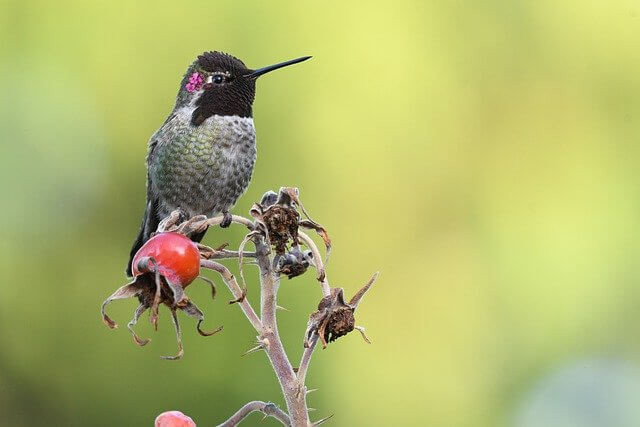
The Anna’s Hummingbird is a small bird found in North and South America. In the 19th century it was named after Anna Massena, Duchess of Rivoli. The hummingbird is found in open woodlands, gardens, and chaparral habitats. It feeds on nectar from flowers and also eats insects. The Anna’s Hummingbird has a large range that extends from Alaska to Panama. It is the only hummingbird that breeds in Canada.
The bird is common in urban areas and can often be seen near houses and gardens. The diet of the Anna’s Hummingbird consists mainly of nectar from flowers. The bird will also eat insects, such as spiders and ants. The hummingbird uses a superlong tongue to pierce the densest parts of flowers to sip the nectar contained within.
- Frequency: 18.38%
- Color: Iridescent bronze-green back, a pale gray chest, belly, and green flanks.
- Habitat: Open-wooded, shrubby areas and mountain meadows across the Pacific coast.
- Range: New York, Florida, Louisiana, Newfoundland, California, Baja California, Arizona, Oregon, Washington, Alaska, Saskatchewan, and British Columbia.
- Size: 3.9 – 4.3″ inches long
- Weight: 3 – 6 grams
- Diet: Nectar, Insects, arthropods
- Family: Trochilidae
- Genus: Calypte
Related: 31 Flowers That Attract Hummingbirds (Photos, ID & Info!)
Mourning Dove
The Mourning Dove is a North American bird that ranges anywhere from southern Canada to northern Mexico. The typical habitat for this bird is an open area with some trees nearby, such as a field or meadow. The diet of the mourning dove consists mostly of seeds, but they will also eat insects on occasion. The mourning dove is a relatively small bird, measuring only about 11 to 13 inches in length.
The body is grayish-brown on top and white on the bottom, with two black stripes running down the neck. The wings are pointed and have dark bars on them. The tail is long and tapered, with a black band at the end. The mourning dove gets its name from its call, which sounds like it is grieving or mournful. This sound is made by both sexes and is used to communicate with other doves.
- Frequency: 15.58%
- Color: Light gray-brown and lighter and pinkish below. The wings have black spots.
- Habitat: Open habitats, urban areas, farms, prairie, grassland, wooded area
- Range: USA, Canada, Mexico, Central America, Greater Antilles
- Size: 11-13″ inches length
- Weight: 112 – 170 grams
- Diet: Rapeseed, corn, millet, safflower, sunflower seeds, pokeberry, sesame, and wheat.
- Family: Columbidae
- Genus: Zenaida
Related:
- Facts About Mourning Doves – 10 Things You Need To Know!
- Best Bird Feeder For Doves (Reviewed & Tested for 2022)
Red-breasted Nuthatch
The Red-breasted Nuthatch is a small, sprightly bird with a black cap and upperparts, white underparts, and a rust-colored breast. This nuthatch ranges across much of North America, from Alaska and Canada to the southern United States. The bird is found in both coniferous and deciduous forests, often near the edge of woods or in open areas with scattered trees.
The Red-breasted Nuthatch feeds on insects and spiders, which it catches by climbing up and down tree trunks and branches. The nuthatch also eats seeds and nuts, which it pries open with its strong bill. In wintertime, when food is scarce, the Red-breasted Nuthatch may form small flocks and forage together.
- Frequency: 15.39%
- Color: Bluish gray upperparts with reddish brown underparts, a white face and throat with a black stripe runs through the eyes.
- Habitat: Coniferous trees but can also be found in mixed woods, backyards, and parks.
- Range: Canada and USA
- Size: 4.5″ inches long
- Weight: 9.9 grams
- Diet: Berries, suet, small seeds, carrion, grasshoppers, and various insect larvae, and crustaceans.
- Family: Sittidae
- Genus: Sitta
Related: How to Attract Nuthatches to your Backyard? Expert Tips!
American Goldfinch
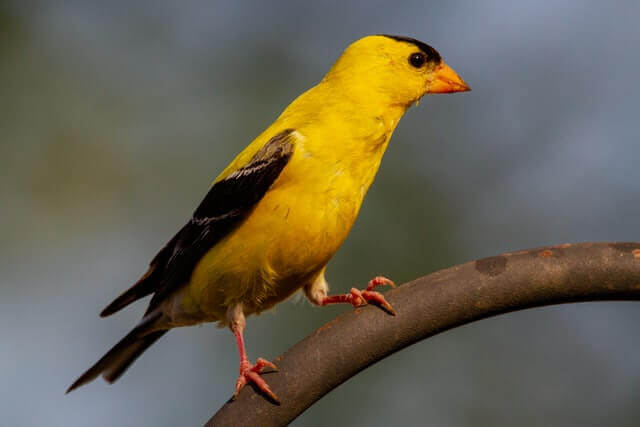
The American Goldfinch is a small bird that is similar to a sparrow, with a yellow body and black wings. The male goldfinch has a black cap, whereas the female has a brown cap. These birds are found in open woods and meadows across North America. They are also common visitors to backyard bird feeders. American goldfinches eat mostly seeds and insects. In the summer, they eat thistle seeds and other small seeds.
In the winter, they eat sunflower seeds and other larger seeds. They also eat insects, such as aphids and caterpillars. These birds nest in trees or shrubs, often near the ground. The female builds the nest out of plant material, such as twigs, leaves, and grasses. The male helps to gather materials for the nest, but does not help with construction.
- Frequency: 14.99%
- Color: Face, neck, and underside are yellow, black wings with white bars.
- Habitat: Deciduous forests and thickets, roadside, grasslands, backyards, meadows.
- Range: Canada, USA and Mexico
- Size: 4.3 – 5.5″ inches length
- Weight: 12 -18 grams
- Diet: Grass, dandelions, chickweed, sunflowers and ragweed, thistle, red alder, birch, spruce seeds.
- Family: Carduelinae
- Genus: Spinus
Related: American Goldfinch Interesting Facts
Common Raven
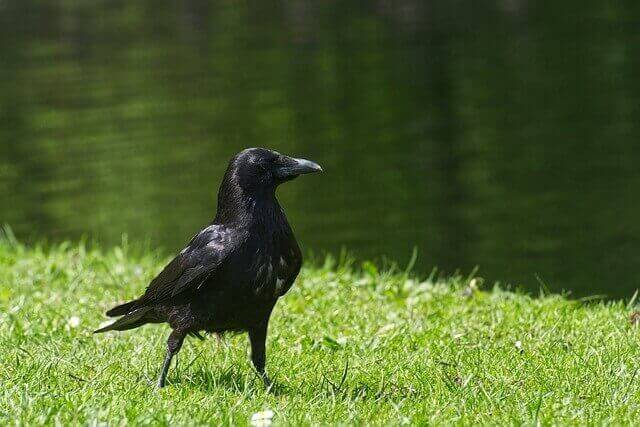
The Common Raven (Corvus corax) is a big black bird that is often seen in North America. Ravens are members of the Corvidae family, which also includes crows, jays, choughs and magpies. They are among the largest of the corvids, with a wingspan of 24-30 inches (61-76 cm) and a body length of 21-26 inches (56-69 cm). Males and females have the same appearance and size.
Ravens occur throughout much of the Northern Hemisphere, including most of Canada, Alaska, parts of the western United States, Europe, Russia and Asia. In North America, they are primarily found in mountainous areas, while in Eurasia they occur in both mountain and lowland habitats. Ravens generally prefer open country with some trees or cliffs for roosting and nesting sites.
- Frequency: 14.67%
- Color: All black iridescent plumage
- Habitat: Wooded areas, evergreen forests, tundra, roadside, grasslands, backyards, parks.
- Range: Found throughout the Northern Hemisphere.
- Size: 21 – 26 inches long
- Weight: 1.5 – 4.5 lbs.
- Diet: Mainly scavengers, feeding on carrion, beetles, and maggots.
- Family: Corvidae
- Genus: Corvus
Related: 18 Fun Facts About Ravens That Will Amaze You
White-crowned Sparrow
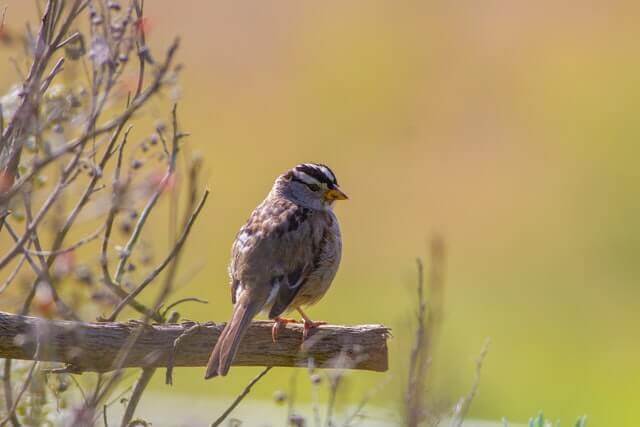
The White-crowned Sparrow is a bird that can be found in North America. The range of the White-crowned Sparrow extends from Alaska to Newfoundland, and southward to California and New Mexico. The habitat of the White-crowned Sparrow is open woodlands or scrublands. The White-crowned Sparrow’s diet includes insects, seeds, and berries.
The White-crowned Sparrow is a small bird with a brown back and white underparts. The male has a gray crown with black streaks, while the female has a brown crown with no streaks. Juvenile plumage is similar to that of a female adult. The White-crowned Sparrow breeds in open woodlands or scrublands across North America. The nest is built on the ground, hidden among vegetation.
- Frequency: 14.52%
- Color: Black and white stripes on their head, gray face, brown-streaked upper, and a long tail. Brown wings with bars and the underparts are gray.
- Habitat: Brushy areas
- Range: Western USA, and Northern Canada
- Size: 5.9″ – 6.3″ inches long
- Weight: 25 – 28 grams
- Diet: Seeds, insects, and plants
- Family: Passerellidae
- Genus: Zonotrichia
Yellow-rumped Warbler
The Yellow-rumped Warbler is a small New World warbler. The adult has yellow upperparts, including the crown and rump, and grayish-white underparts. The head has a black mask through the eye and there is a conspicuous yellow patch on the back of the head. The wings are gray with two white bars. It is one of the more common warblers in North America, breeding in deciduous and coniferous forests across much of Canada and the northern United States.
It is a rare vagrant to Western Europe. This species is generally resident within its breeding range, although some birds may move south in winter. The Yellow-rumped warbler typically nests in trees, laying four to six eggs in a cup nest lined with hair or plant down.
- Frequency: 14.49%
- Color: Yellow patches on the crown, flanks, rump & blackish-blue streaks on the back, breast and wings.
- Habitat: Deciduous forests and thickets, roadside, grasslands, backyards.
- Range: U.SA, Canada, Mexico, Central America, and the Caribbean.
- Size: 4.7 – 5.9″ inches
- Weight: 10 – 18 grams
- Diet: grasshoppers, gnats, aphids,caterpillars, wasps, beetles, spiders, berries.
- Family: Parulidae
- Genus: Setophaga
Related: How to Attract Warblers to your Yard?
Golden-crowned Sparrow
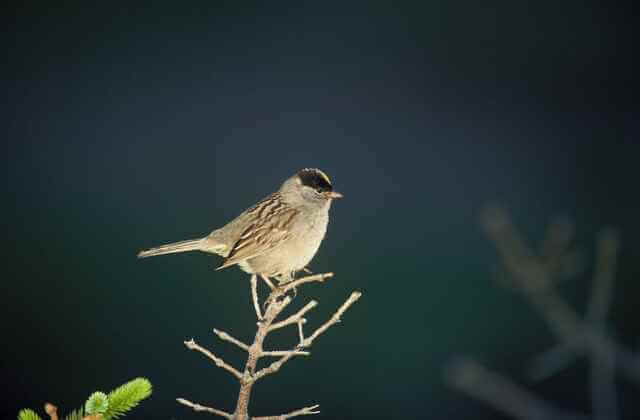
The Golden-crowned Sparrow (Zonotrichia atricapilla) is a medium-sized sparrow with a rusty-brown back and grayish breast. The golden crown for which it is named is only visible in the breeding season. This sparrow breeds in open coniferous forests in Alaska and western Canada and winters in coastal scrub, chaparral, and other brushy habitats along the Pacific Coast from British Columbia to northern Mexico.
The diet of the Golden-crowned Sparrow consists mainly of insects and seeds. In the breeding season, insects make up a large part of the diet, while in the winter, seeds become more important. This sparrow forages primarily on the ground, scratching through leaf litter or soil to find food.
- Frequency: 13.23%
- Color: Upperparts are grayish-brown, with brownish-black streaks on the back, underparts are gray.
- Habitat: Forest edges, tundra, high alpine meadows, thickets, fields, roadsides, and backyards.
- Range: Eastern North America, from Nova Scotia to Florida
- Size: 6″ – 7″ inches
- Weight: 19 – 35.4 grams
- Diet: Seeds, berries, flowers and buds from plants, and insects
- Family: Passerellidae
- Genus: Zonotrichia
The Backyard Birds Below Have A Frequency Of Less Than 13% All Year-round
- Bewick’s Wren – 13.08% Frequency
- Lesser Goldfinch 11.75%
- Barn Swallow 11.70%
- Chestnut-backed Chickadee 11.45%
- Violet-green Swallow 11.16%
- Eurasian Collared-Dove 11.14%
- Killdeer 10.97%
- Ruby-crowned Kinglet 10.96%
- Downy Woodpecker 10.87%
- House Sparrow 10.69%
- Tree Swallow 10.59%
- Brewer’s Blackbird 10.55%
- Bushtit 9.98%
- Cedar Waxwing 9.48%
- Black-headed Grosbeak 8.49%
- Common Yellowthroat 8.12%
- Golden-crowned Kinglet 7.84%
- Belted Kingfisher 7.78%
- Brown Creeper 7.73%
- Pine Siskin 7.72%
- Pacific Wren 7.72%
- Western Wood-Pewee 6.74%
- Fox Sparrow 6.71%
- Brown-headed Cowbird 6.68%
- Orange-crowned Warbler 6.62%.
- White-breasted Nuthatch 6.49%
- Western Tanager 6.41%
- Purple Finch 6.22%
- Varied Thrush 6.13%
- Rufous Hummingbird 6.00%
- Savannah Sparrow 5.96%
- Swainson’s Thrush 5.92%
- Western Meadowlark 5.78%
- Wilson’s Warbler 5.66%
- Rock Pigeon 5.51%
- Mountain Chickadee 5.05%
Frequently Asked Questions
What bird is Oregon known for?
The Western meadowlark is the U.S. state bird of Oregon. This bird is known for its beautiful song, which can be heard throughout the state. The Western Meadowlark is a member of the family Icteridae, which includes blackbirds, orioles, and other brightly colored birds. In Oregon, you’re likely to hear its cheerful song during the springtime.
What is the largest bird in Oregon?
The largest bird in Oregon is the California Condor. These massive birds can weigh up to 26 pounds and have a wingspan of up to 10 feet. Condors are scavengers and can often be seen feeding on carcasses of animals. While they are not endangered, their populations have been in decline in recent years.
What Oregon birds nest on the ground?
There are many Oregon birds that nest on the ground, including sparrows, grosbeaks, buntings, and towhees. These birds typically build their nests in areas with dense vegetation, where they can be well hidden from predators. The ground provides these birds with a safe place to raise their young.
What kind of chickadees live in Oregon?
There are three species of chickadees that live in Oregon, the Black-capped Chickadee, Chestnut-backed Chickadee, and Mountain Chickadee. The Black-capped Chickadee is the most common species in Oregon.
Are there grackles in Oregon?
There are two species of grackles that are found in Oregon, the Great-tailed Grackle and the Common Grackle. Both species are found in the eastern part of the state. The Great-tailed Grackle is more common in urban areas, while the Common Grackle is more often found in rural areas.
Are there orioles in Oregon?
There are six species of orioles that have been documented in the state of Oregon. They are the Bullock’s Oriole, Orchard Oriole, Hooded Oriole, Baltimore Oriole, Scott’s Oriole, and Streak-backed Oriole. All of these birds are members of the family Icteridae, which contains all the New World orioles. The Bullock’s Oriole is the most common oriole found in Oregon.
Are there peacocks in Oregon?
Yes, there are peafowls in Oregon, but they are very rare. According to eBird the frequency of occurrence is only 0.0013%. Peafowls typically inhabit woodlands and forests near water sources, where they can find food and shelter.
Are golden eagles in Oregon?
Although golden eagles are not as common in Oregon as they are in other parts of the United States, they can still be found in the state. According to eBird, the frequency of occurrence for golden eagles in Oregon is only 0.7576 percent. However, this does not mean that they are impossible to find. There have been several sightings of golden eagles in Oregon over the years, and they are sometimes seen flying near Crater Lake National Park. If you’re lucky enough to spot one of these beautiful birds, it’s certain to be a memorable experience.
Do we have cardinals in Oregon?
No Cardinals are not native to Oregon; the closest breeding populations of cardinals are found in California and Idaho. Cardinals are a non-migratory bird, which means they don’t typically travel far from their nesting area. So, while you might see a cardinal in Oregon, it’s more likely that the bird is just passing through on its way to somewhere else.
Are there starlings in Oregon?
The European Starling is the only species of starling present in Oregon. This bird is very common in the state, and can be found in a variety of habitats. Starlings are not native to Oregon, but were introduced to the state in the early 1900s. They have since thrived and can now be found in many different parts of the state.
What kind of black birds are in Oregon?
There are five species of blackbird that can be found in Oregon: the red-winged blackbird, Brewer’s blackbird, yellow-headed blackbird, tricolored blackbird, and rusty blackbird. All of these species are found in a variety of habitats throughout the state, though they typically prefer areas with lots of trees and shrubs. Red-winged blackbirds are the most common type of blackbird in Oregon, and they can be found in nearly every type of habitat.
Are there vultures in Oregon?
There are two species of vultures that can be found in Oregon, the Turkey Vulture and the Black Vulture. The Turkey Vulture is the most common. These birds are scavengers and can often be seen circling over roadkill or other carrion. They have a very keen sense of smell and can find food that is hidden or buried.
Do we have falcons in Oregon?
There are 4 species of falcon that call Oregon home – the Peregrine Falcon, Prairie Falcon, Gyrfalcon, and Lanner Falcon. The Peregrine Falcon is the most widely distributed of all the falcon species, and can be found on every continent except Antarctica. In North America, they can be found from Alaska all the way down to Mexico. In Oregon, they typically nest on cliffs near rivers or along the coast.
Related Post:


